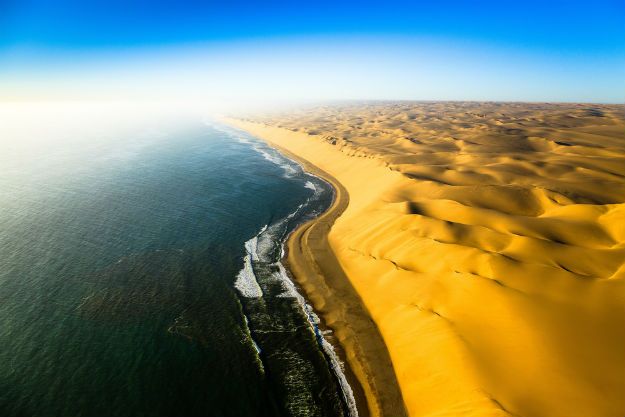Namibian Rhapsody: A Landscape Photographer's Baptism by Fire

The stark silence of the Namib wasn't the most shocking thing about it; the sheer brutality of the sun was. As a landscape photographer accustomed to the icy grips of Iceland and the rugged terrains of Alaska, I thought I understood extremes. But Namibia? Namibia was a different beast altogether, a furnace where the landscape demanded respect, resilience, and a whole new set of photographic skills. This adventure travel Namibia would redefine my understanding of light, shadow, and the sheer power of nature.
From Ice to Inferno: My Initial Impressions
Leaving behind the familiar chill, I landed in Windhoek, the capital, and immediately felt the dry heat wrapping around me like a heavy blanket. It was a far cry from the biting winds I was used to, a complete sensory overhaul. The vastness of the Namib Desert, however, was even more striking. It stretched out like an endless ocean of sand, an intimidating yet incredibly alluring canvas. I was here for Namibia landscape photography, ready to capture its raw beauty, but I quickly realized I was woefully unprepared for the challenges that lay ahead. The Namib wasn’t just a different landscape; it was a different planet. My Fujifilm GFX100S with a GF32-64mmF4 R LM WR lens was about to get a serious workout.
Floating Over Sossusvlei: A Sunrise Spectacle
My baptism by fire began with a hot air balloon ride over Sossusvlei. Waking before dawn, I arrived at the launch site, the air still cool enough to be almost pleasant. As the balloon ascended, the first rays of sun kissed the towering red dunes, transforming them into fiery sculptures. The shifting colors were mesmerizing, the deep shadows playing against the vibrant orange and red hues. The silence was broken only by the rhythmic whoosh of the burner, a sound that echoed across the desolate landscape.
I attempted a long exposure shot, hoping to smooth out the sand and capture the movement of the light. With my camera firmly mounted, I aimed to silhouette myself in the foreground, a small figure against the immensity of the dunes. Capturing Namib desert at sunrise required quick thinking and adjusting to rapidly changing light conditions.
Sandboarding Down Dune 7: A Thrilling Descent
Next up: sandboarding down Dune 7, one of the highest dunes in the world. The climb was arduous, the sand giving way with every step. Reaching the summit, I was blasted by a hot wind, the taste of dust coating my tongue. Protecting my camera gear became paramount, wrapping it in cloths and constantly checking for any invading grains.
The descent was exhilarating, a blur of motion and adrenaline. The challenge was keeping my balance while trying to capture the experience with my GoPro. It was chaotic, messy, and utterly unforgettable.
4x4 Safari: Searching for Desert Survivors
A guided 4x4 safari offered a different perspective on the Namib. We ventured into the gravel plains and rocky outcrops, searching for desert elephants and oryx. The stark beauty of this landscape was undeniable, but photographing wildlife in such an unforgiving environment proved difficult. The heat haze distorted the images, and the animals were often far away.
Patience was key, and I learned to appreciate the subtle details of the desert, the way the light played on the rocks, the resilience of the desert flora. This safari truly tested my ability to adapt to desert photography challenges.
Skeleton Coast from Above: A Hauntingly Beautiful Flight
The scenic flight over the Skeleton Coast was a highlight of the trip. From above, the shipwrecks scattered along the coastline looked like forgotten toys, a testament to the power of the sea. The massive seal colonies sprawled along the beaches, a cacophony of life against the desolate backdrop.
I tried to capture the stark contrast between the red sand dunes and the harsh Atlantic coastline, aiming for a wide shot of a shipwreck in the distance, emphasizing the desolation and remoteness of the area. Flying over this coastline was an adventure travel Namibia experience like no other.

Stargazing in NamibRand: A Cosmic Embrace
As a Gold Tier Dark Sky Reserve, the NamibRand Nature Reserve offered an unparalleled stargazing experience. The immensity of the night sky was breathtaking, the Milky Way stretching across the horizon like a river of light. I felt utterly alone, yet completely connected to the universe. Setting up my tripod, I spent hours capturing the brilliance of the stars, feeling a profound sense of peace in the vastness of the desert. Where to photograph stars in Namibia? Look no further than NamibRand.
A Culinary Journey: Tastes of Namibia
The food experiences in Namibia were as diverse and captivating as the landscape. The Namibian culture travel tips I picked up encouraged me to dive in to the local cuisine. A "braai" (barbecue) featuring game meats like kudu and springbok was a carnivore's delight. The rich, smoky flavors were a perfect complement to the rugged surroundings. Fresh oysters from Walvis Bay, enjoyed with a view of the lagoon, were a refreshing contrast, a taste of the sea in the desert. A "biltong" (dried, cured meat) tasting with local craft beers offered a glimpse into the local flavors and traditions. And a fine dining experience at a lodge, showcasing Namibian cuisine and incorporating indigenous ingredients like !Nara melons, was a sophisticated culinary adventure.
Photography Challenges and Triumphs
The Fujifilm GFX100S with a GF32-64mmF4 R LM WR lens proved to be a reliable companion, but the Namib presented unique challenges. Sandstorms were a constant threat, requiring meticulous cleaning of the lens after every outing. The heat haze often blurred distant objects, making sharp images difficult to achieve. Dealing with extreme dynamic range – the bright sun versus the deep shadows – was a constant balancing act. However, I leveraged the medium format sensor's dynamic range to capture details in both the highlights and shadows, creating images that truly reflected the scene's nuances. I am constantly having to deal with heat in the Namib desert while keeping my photography equipment running.
My image style, inspired by Michael Kenna but in color, emphasized minimalist compositions, long exposures (thanks to ND filters) to smooth out the sand, and capturing the subtle variations in tone and texture.

Deadvlei: A Surreal Masterpiece
Deadvlei, with its skeletal trees against the white clay pan, was perhaps the most surreal and captivating location I encountered. The stark beauty and otherworldly atmosphere were unlike anything I had ever seen. I rendered my photograph of Deadvlei in black and white, emphasizing the dramatic contrast between light and shadow, capturing the timeless and haunting beauty of this unique landscape.
Ethical Travel: Preserving Namibia's Beauty
Namibia is committed to sustainable tourism practices, and it's crucial to support these efforts. Many eco-lodges prioritize environmental protection, and responsible tour operators work closely with local communities. I spoke with a local conservationist who emphasized the importance of balancing tourism with environmental preservation: "We want to share the beauty of Namibia, but we must also protect it for future generations. It's a delicate balance, but one we are committed to achieving."
Sensory Overload: The Namibian Experience
The feel of the hot wind on my skin, the taste of dust in the air, the sound of silence in the desert (broken occasionally by the cry of a jackal), and the smell of the sea air mingling with the desert dust – these sensory details are what truly define the Namibian experience. It's a place that assaults your senses, challenges your perceptions, and leaves an indelible mark on your soul.
Conclusion: Lessons from the Desert
Photographing the Namibian landscape was a transformative experience. I learned to adapt to extreme conditions, to appreciate the beauty in the starkest environments, and to respect the power of nature. I can say with confidence that the Namib has become one of my favorite places to engage in Namibian desert photography. The Namib isn't just a desert; it's a teacher. It teaches you patience, resilience, and the importance of embracing the unexpected.
Call to Action
Visit Namibia responsibly and support local conservation efforts. Explore this incredible landscape while minimizing your impact and contributing to its preservation for future generations.
- Namibia Tourism Board: [Insert placeholder link]
- NamibRand Nature Reserve: [Insert placeholder link]
- Integrated Rural Development and Nature Conservation (IRDNC): [Insert placeholder link]